Recent Articles
-
Daniel Cooney Fine Art holds Emerging Photographers Auction at www.iGavel.com until January 21st
-
Reflections on the Internet, Art and Politics
-
The Amalgamation of Creative Media
-
Art in the New World Order: Part II
-
Art in the New World Order: Part I
Categories
- #SANDY
- 2016
- 27th International Festival of Photojournalism
- Aaron Vincent Ekraim
- Africa
- AIPAD
- Almond Garden
- American Photo
- Anna Beeke
- Aperture
- Art Desks
- Artist Events
- Artist talk
- Award
- Awards
- Barmaid
- Barney Kulok
- Behold
- Best of 2015
- Book Launch
- Book release party
- book signing
- Book signings
- Book-signing
- Bryan Schutmaat
- Call for applicants
- call for entries
- Cara Phillips
- CDS
- Chicago
- ClampArt
- Closing Exhibition
- Competition
- Conservation photography
- Contests
- Cowgirl
- Critical Mass
- Cyril Christo
- Daily Mail
- Daylight
- Daylight Books
- Daylight Digital
- Daylight Digital Feature
- Daylight Photo Awards
- Daylight Project Space
- dj spooky
- Documentary Photo
- DPA
- Dread and Dreams
- E. Brady Robinson
- Eirik Johnson
- Elaine Mayes
- Elinor Carucci
- Events
- Every Breath We Drew
- exhibit
- Exhibition
- Exhibitions
- Fall 2015 Pre-launch
- Festivals
- Film Screening
- Film screenings
- Fine Art
- Flanders Gallery
- Fotobook Festival Kassel
- Françoise Callier
- From Darkroom to Daylight
- Frontline Club
- Gabriela Maj
- Gays in the Military
- george lawson gallery
- GuatePhoto
- Guatephoto Festival
- Hariban Award
- Harvey Wang
- hochbaum
- Home Sweet Home
- Huffington Post
- Hurricane Sandy
- Interview
- J.T. Leonard
- J.W. Fisher
- Janet Mason
- Jess Dugan
- Jesse Burke
- John Arsenault
- Jon Cohen
- Jon Feinstein
- Katrin Koenning
- Kuala Lumpur Photo Awards
- Kwerfeldein
- L'Oeil de la Photographie
- LA
- Landmark
- Leica Gallery
- Lenscratch
- LensCulture
- Library Journal
- Lili Holzer-Glier
- Lori Vrba
- Lucas Blalock
- Malcolm Linton
- Marie Wilkinson
- Mariette Pathy Allen
- Michael Itkoff
- Month of Photography Los Angeles
- Mother
- Multimedia
- Nancy Davidson
- New York
- New York City
- News
- NYC
- ONWARD
- Opening
- Opportunities
- Ornithological Photographs
- Out
- Party
- Philadelphia
- Photo Book
- Photo Booth
- photo-book publishing
- PhotoAlliance
- Photobooks
- Photography
- Photography Festival
- photolucida
- Poland
- portal
- Pre-Launch
- Press
- Prize
- PSPF
- Public Program
- Raleigh
- Rayko Photo Center
- Recently
- Rencontres De Bamako
- Reviews
- Robert Shults
- Rockabye
- Rubi Lebovitch
- San Francisco Chronicle
- Seeing Things Apart
- SF Cameraworks
- silver screen
- Slate
- slideluck
- Sociological Record
- Soho House
- spring 15
- Spring 2016
- Stephen Daiter Gallery
- Sylvania
- Talk
- Tama Hochbaum
- The Guardian
- The Moth Wing Diaries
- The New Yorker
- The Photo Review
- The Solas Prize
- The Superlative Light
- The Telegraph
- TIME
- Timothy Briner
- Todd Forsgren
- Tomorrow Is A Long Time
- TransCuba
- Upcoming events
- USA Today
- VICE
- Vincent Cianni
- Visa Pour L'Image
- Vogue
- We Were Here
- Wild & Precious
- Wired
- Workshop
- Zalmai
- Zofia Rydet
News
Daniel Cooney Fine Art holds Emerging Photographers Auction at www.iGavel.com until January 21st
Posted by Daylight Books on
Featuring the work of:
Juliana Beasley, Timothy Briner, Nina Buesing, Tom Chambers, Megan Cump, Clayton Cotterell, Adrienne De Boer, Matt Eich, Sam Falls, Jon Feinstein, Mark William Fernandes, Amy Finkelstein, Lucas Foglia, Kyle Ford, Chuck Hemard, Oded Hirsch, Whitney Hubbs, Michael Itkoff, Dave Jordano, Christopher La Marca, Nyra Lang, Shane Lavalette, Pixy Liao, Walter Lockwood, Jennifer Loeber, Oz Lubling, Sara Macel, Jay Matthews, John Mann, Eri Morita, Carolyn Monastra, Nik Mirus, Sarah Palmer, Lydia Panas, Toni Pepe, Bradley Peters, Jeffrey Rich, Nadine Rovner, Noel Rodo Vankeulen, Shen Wei
ALL PHOTOGRAPHS AVAILABLE FOR VIEWING AT:
Daniel Cooney Fine Art
511 West 25th Street, #506
New York, NY 10001
t: 212 255 8158
f: 212 255 8163
www.danielcooneyfineart.com
ALL RESERVES $200
Reflections on the Internet, Art and Politics
Posted by Daylight Books on
Since this was my first experience blogging, I thought I would finish the series with my thoughts on the internet. Of course, this is a very broad topic so I will narrow it down by musings about the ways in which online material and activity affects the art world versus the way it affects politics and current events.
I'll begin with my observations over the past month while writing for this blog. When I agreed to be a guest writer, I had some preconceived ideas of what this type of writing would entail. Based on other blogs I've read, I envisioned a slew of commentary following each post. In a way, I was looking forward to hearing what people had to say on the comment board. After all, I'm only one voice with one point of view. What I have often found with the comment boards, however, is that they often descend into junior high level, base insults and one-upmanship. I attribute this to the anonymity of the comment board format and the realization that a lot of people simply aren't very nice when they don't have to talk to someone face to face. I anticipated this possibility too.
As it turns out (the current post not-withstanding) I have yet to see a posted comment on the comment board, yet I have received many emails sent directly to me regarding the posts. All of the emails were respectful, mature, intelligent and positive which has certainly improved my general view of the blogging format. I recently mentioned this lack of comment board activity to artist/designer Colleen Plumb who seemed to understand why people might be reluctant to post on a public forum. "You're really putting yourself out there," was her comment. It appears that the downward spiral of immature insults and one-liners that we are all familiar with on comment boards has dissuaded those who would maintain the forum as a vehicle for intelligent discourse.
So, the blog seems to have evolved into something that I feel can be very beneficial for the arts. The declining use of the comment boards allows bloggers to post essays without the distraction of the inherent weirdness that comes with the open commentary. The blog becomes more like a published journal or 'zine without the cost of production or the exclusivity associated with academic writing. Art is a subjective subject matter that can only benefit from broader discourse. Perhaps this format can help to loosen the hegemony of the academic, gallery and museum system by giving voices to intelligent, working artists, critics and thinkers. Perhaps…
On the flip side, the blog becomes problematic when dealing with current events and politics. The issue is the damage that misinformation, hate-mongering and outright lying has imposed on the collective psyche. Even before the popularization of the political blog, our news outlets had abandoned the idea of impartial news reporting. They like to advertise that they are "fair and balanced," "no bias, no bull," but we all know that each outlet comes with it's own slant. In some cases the slant is more like a steep pitch, or even a sheer cliff. If you don't understand what I'm talking about here, try watching The National on Canada's CBC network. Possibly one of the driest news reports you'll ever find, but you get the information in a straight forward, matter-of-fact manner that leaves much of the analysis up to the viewer (with a Canadian bias, of course). It would never fly in the U.S. because it gets a D- for entertainment value.
We are at a point in history where we can't trust any of the information we are given. I suppose this has always been true to an extent but it seems to have gotten more pronounced with the media and technology explosion over the past two decades. At first, the blog seemed like a good way to counteract this phenomenon by putting some power back in the hands of the people. Anyone could write about anything they wanted and we would be able to get information from thousands of sources beyond the mainstream media. It may have worked like this for a while, and it may still to some extent, but the very qualities that make blogging and the internet an excellent forum for art, make it wrought with problems when applied to news. If we can't be sure of our news outlets who are held to a certain code of conduct and ethics, how are we to decide what is credible from someone writing a blog who isn't subject to any checks or codes of conduct?
It seems to me that the last thing we need right now is more political bloggers. Perhaps this is evidenced by the alarming number of Americans who continue to maintain that Barack Obama is a Muslim despite every available fact placing him in the Christian faith. I don't know what is more disturbing; the fact that people are so confused about what to believe that they'll believe outright lies, or the darkly racial issue of his faith being an issue at all. I'm sorry all you young Muslim-Americans, apparently you are not allowed to dream of becoming president just yet.
But I digress. My long-winded point is that the blog format seems to be fantastic for things that are clearly opinion-based (like this essay) but problematic as an outlet for fact-based information, especially if it is masquerading as opinion (this means you Rush).
Enough about blogs for now. In 1994, James Enyeart, director of The George Eastman House, wrote his essay Pathways to the Future of Digital Imaging for the journal Image. In it he makes a number of predictions about the future of the photographic medium and art in general. He puts himself a ways out on a limb by suggesting that in the future we would be dealing with entire museums based on CD-ROM. The idea would be that we would interact with the art spontaneously and selectively on computer screens rather than viewing the actual objects on the wall or in the gallery. This would put far more art at the viewers finger tips since the number of pieces viewed would not be limited by the available space in the gallery.
Thank goodness we haven't come to that yet and I think most of us would have a hard time envisioning an entire museum basing itself on files stored on CD-ROMs, DVDs or any other storage media for that matter. However, in a way, he wasn't that far off when it comes to experiencing art via the screen. Without a doubt, the vast majority of photographs the average American citizen encounters in 2009 is via the internet and ever-shrinking LCD screens. Most of these images are not presented as "art" images unless we are doing searches for "art" photographers. But the majority of contemporary artwork that I am familiar with today I have never seen in print form. I'm familiar with the artist's website or their Flickr page but the interaction with the work is facilitated by ones and zeroes. I realize that this is true of my work as well and it's evidenced by people's reactions when they see my exhibition prints on the wall. I am currently producing portfolio books for all my galleries because I realized last summer that they were all using my website to show the work to collectors. I felt that image samples on paper would be a better way to sell the work than through crappy jpegs off a website.
The question is, how far will we go toward Enyeart's prediction? Brian Ulrich recently taught a class at Columbia College Chicago called The Medium is the Message which was based in non-print photography (and a lot of Marshal McLuhan). One of my students this Fall chose to present his entire final project on a 30" LCD television which he wheeled into class on a luggage cart. Are we actually heading away from the printed image? How many personal photographs sit on people's hard drives and never see paper at all? If we are, it has staggering implications for the gallery/museum paradigm. That may be a good thing, or a bad thing, but it is definitely a thing.
I think there will always be a place for the commodification of the photographic print. I personally still prefer to view images in print form but I think it is important to be aware of these potential changes. If we want to be forward-thinking artists, we need to be more than aware. We need to be looking for ways to embrace the unprinted image to find out what it's does well and what it doesn't do well. As a culture, the screen has become our most familiar medium through which to view photographs, videos, etc.. There have to be an enormous number of ways in which this can be taken advantage of by the art world beyond the artist's portfolio website.
I am starting to feel echoes of David Carson's The End of Print from the early 1990s which proposed that the internet would be the death of the printed word and a transformer of graphic design. He was right to a certain degree with the dramatic drop in printed newspapers and magazines but rather than seeing the "end" of print altogether, we are starting to see the re-emergence of the small-time printing houses dedicated to producing short-run printed books and 'zines. I wonder if photography will have a parallel to this in another ten or fifteen years. Maybe it already does?
This final blog entry ended up much more rambling than I anticipated. Although I have many criticisms to offer the internet and all it encompasses, I can definitively say that I wouldn't be where I am today without it. Without a website, blogs and email, the job of self promotion becomes much more difficult and slow. How did they do it before we had all these great tools at our disposal? It is also fair to say that I wouldn't be aware of as many young and emerging artist as I am today if it weren't for their websites, blogs and inquiring emails.
Before I sign off, I would specifically like to thank Taj Forer, Ethan Clauset and Brian Ulrich for giving me the opportunity to write for Daylight Magazine. I would particularly like to commend Taj and Ethan for running a publication with integrity and a genuine sense of intelligent discourse. At this point, we are our own overseers and these guys are setting and excellent example for honest, responsible and independent publication.
MS
The Amalgamation of Creative Media
Posted by Daylight Books on
My fourth post is going to keep with the introspective nature of the last one. While the previous post dealt with the changing nature of socio-politically motivated art, this post will address the more concrete issue of the medium of art. This is something I've been thinking about for several years and have found myself going through many phases in my thinking and attitude towards it. I have a feeling that my trajectory isn't all that different from many other artists working in photo-centric art today.
Let me back up a little and explain how and why I got into photography in the first place. I was brought up in a very secular, scientific household. Both my parents are doctors and my younger brother recently followed in their footsteps. My grandfather was an engineer and my grandmother a technical drawer so logic and the empirical process were heavily valued. This isn't to say, however, that creativity wasn't encouraged.
My grandfather was a serious amateur photographer beginning in the early 1930s in Germany. He owned Leica's and Rolleiflexes and used them continuously. On top of being a meticulous technician, he was a pretty good image maker as well. He ended up working for Messerschmitt, the German aviation company during WWII which is where he met my grandmother. He was fortunate for many reasons, but the fact that his mother was French allowed him to survive the war without being forced into the Nazi party (something he dreaded). His photographs of the time depict a dark, difficult, but fascinating period in my family history. They also speak to his skill with the camera.

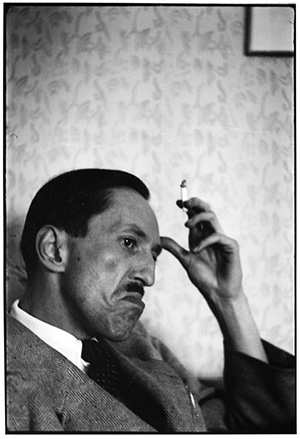
My father was also a serious amateur photographer and was largely responsible for my personal interest in cameras as a child. He bought me my first two cameras: a plastic Kodak Instamatic 126 when I was nine, and a Pentax K1000 when I was eleven.
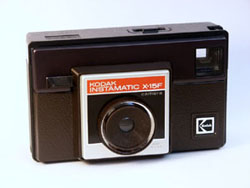
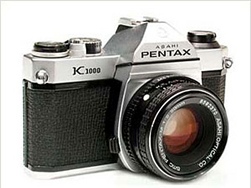
The point of all this personal background is to show how I gained entry into the creative world. I was not particularly adept at any of the traditional arts. I couldn't draw very well. I was even less skilled with a paint brush. My efforts in a soapstone carving class in summer camp were mediocre at best. My dexterity was not a fluid creative outlet for me, but I still had an eye for visual creativity. The camera offered me this outlet.
I began my professional creative life as a photographer's photographer. I identified myself as a photographer and I embraced the medium with all it's mystique and romanticism. I worked primarily commercially and journalistically in the 1990s while doing my own picturesque black and white work on the side that I sold to Vermont tourists. Looking back, I can see that my strong adherence to the medium was largely a result of my own insecurity and intimidation by other artistic media.

I entered Columbia College Chicago's MFA program in 2000 because I was growing restless in the commercial field. I wanted to see what else I was capable of, knowing full well that I could return to commercial photography if it didn't work out. I was initially shocked at the lack of technical knowledge among my fellow grad students. They seemed to have plenty of creative experience but little technical instruction. At first, I didn't like this, but I quickly realized that they were thinking very differently from the way I had been while working commercially. I was now encouraged to abandon the fetish of the technical and consider image-making a cerebral endeavor. Fortunately, at this point, I had a solid arsenal of technical skills to work with.
It was this shift from a technical emphasis to an expressive one, paired with a couple of classes in Photoshop, that began the loosening of my adherence to the photographic medium. With the expression of ideas first and foremost in my mind, what did it matter what medium I chose for a specific project? Photography is great at some things but terrible at others. Each medium has it's strengths and weaknesses so why not take advantage of the strengths of those mediums that are not photography?
Another critical event that helped push me further into multi-media was a request for design from the Chicago Transit Authority in 2006. The CTA has been working on a long term revitalization project that has seen the renovation and modernization of dozens of train stations around the city. They have a sizable art budget and were asking for designs from three different artists per station. The requirements were like nothing I had ever dealt with before. The piece had to last 100 years which meant that it would have to be made out of tile and glass. Photographs were out of the question (although Jon Gitelson proved me wrong on that one). Essentially, I had to come up with a design for a mosaic!
My design ended up being photo-based, where snap shots of the area outside of the station were translated into color fields. I reduced the exterior environment to show only the people and the signs of the businesses, most of which were still locally owned but were fading quickly.
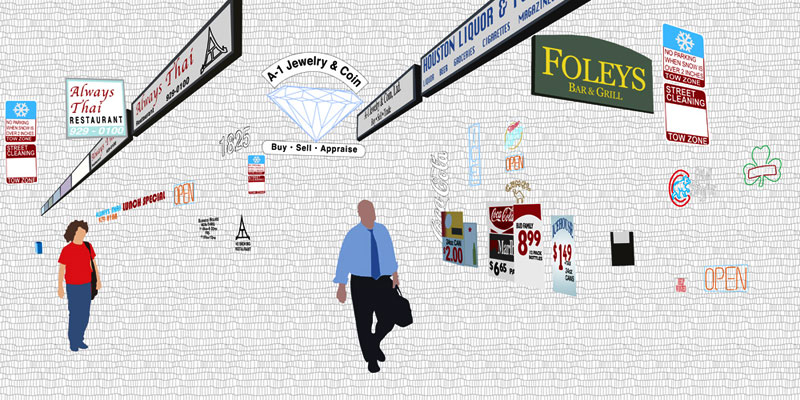
The design was ultimately rejected due to conflicts of interest between the companies who advertise with the CTA and the brands and businesses represented in my proposed mosaics. The lawyers did this one in, but I am looking for another location to do this. It could be done almost anywhere.
Around the same time, I started working on the Compare to… project that used photography but the final result really wasn't a photograph at all. The background was digitally inserted to give an advertising/graphical look to the work. These do not function like the window-on-the-world we are used to interacting with when we look at traditional photography. They are more akin to graphic design in the way they represent the subject. Of course, the photographic material within the piece still implies that the subject actually existed in front of the camera, to some degree at least.
Currently, I am in an odd place creatively. I'm trying to finish up some of my older projects while simultaneously experimenting with some new ideas. There are two, among many, that I am working on right now that have sent me in opposite directions. One of them takes me further from photography and into 3D/objects/sculpture or whatever you'd call it these days. The idea grew out of the Compare to… project which focuses attention on the packaging of products, and The Untitled Project where text is paired with an image. The idea is to aestheticize the shipping crate to make it the object of desire, much the way product packaging works. Secondly, I am working with the idea of pairing words with the objects as a departure from pairing words with images.
Much of this work is still in progress so I'm withholding a little here, but a significant amount of credit for my 3D visualization goes back again to technology. On a recommendation from a friend, I downloaded a free 3D rendering software from Google called Sketchup. It took me about a half hour to figure out the basics and I was rendering away in no time. It's not terribly sophisticated but there is a high-powered version for architects and designers, and I don't really require that level of precision for visualizing what I'm about to build.

At the moment, I am loving working with wood and with objects. There is a different type of interaction people have with objects compared to images and I'm excited to explore those possibilities. I'm not going into deep detail here because much of this isn't presentable yet. The images I have here are from the earlier stages of the process but I should have more posted on my website by the end of January if all goes well.
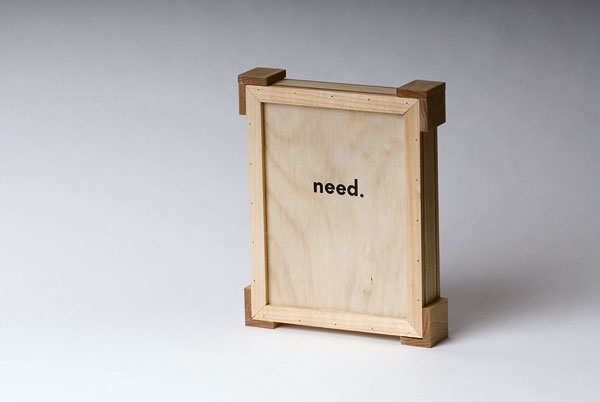
At the same time, I am working on sketches of another idea that is so purely photographic that it verges on the mundane (sometimes that's good, sometimes that's bad). I have spent a lot of time in Europe over the past several years and I've been intrigued by the amount of advertising geared toward the pedestrian compared to the U.S.. I photographed Mr. and Mrs. Smith Go to Paris in 2005 and discovered that more and more of the street level advertising was designed to change quickly. There are rotating kiosks and the glowing sign boxes that scroll up every few seconds.
The idea was to allow the temporal advertisements to dictate the narrative of the sequence by giving the sign control over when the photo was taken. I set up the composition then tripped the shutter each time a new sign faced the camera or flipped up into the box. The ads become the pulse of the activity that is happening around them, once again inserting themselves into the matrix of our daily lives.
These are some sample images of a series I made in Berlin in October. The full series is twenty images but I may end up cutting that down in the end.

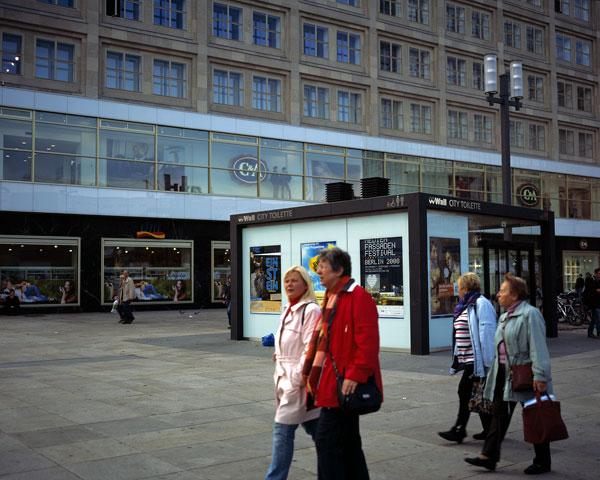
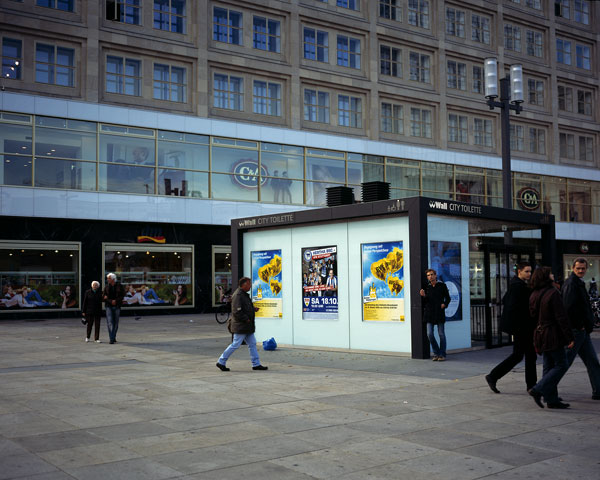
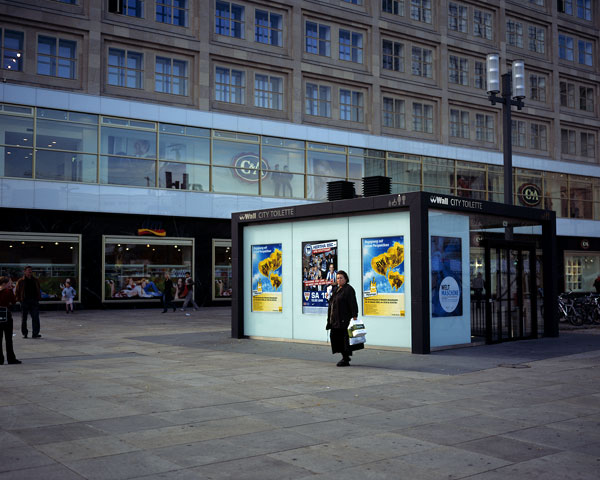
Even though I'm feeling a little less grounded than usual lately, I am enjoying this period immensely. I am realizing that I can explore different media without leaving photography behind. I think that is what is so exciting about making art in the 21st century. We have been released from the confines of our pigeon-holed labels as artists and are able to explore what we want. I'm sure there are many reasons for this but I see two major ones worth mentioning.
First, technology has been a great equalizer for many artists. Learning a few creative programs opens up whole worlds of possibilities that were only accessible to highly trained professionals in the field a few decades ago. Many of these programs work with similar formats making learning new programs that much easier. A great many of my friends and colleagues in the photo field also work in video with programs like Final Cut and even iMovie. Graphic design and 3D design has been made more accessible through programs like Illustrator, Sketchup, Rhino and Maya.
Secondly, the post-modern notion that the art can be conceived by the artist and produced by someone else has been instrumental in broadening the creative scope of contemporary artists. We all recognize our limitations and that we can't be experts at everything. I'm sure some would argue that a photographer has no business making videos or sculptures, and there may be some truth to that. But we are in an age where art can look like so many different things. Some may require machines to produce them(Jeff Koons industrially produced sculptures, for instance) while others are so complex or grandiose that they require teams of experts (Mathew Barney's Cremaster series comes to mind). Not only has this become common practice these days but it has become accepted.
More and more, I have been encouraging my students to learn more programs, to think beyond photography, to watch films, keep up on painting trends and look for work done in new media. This is a controversial issue, as many are reluctant to give up their label as an integral part of their identity as painter, photographer, sculptor, etc.. I have been called pretentious to my face by former photography professors for referring to myself as an artist rather than a photographer. I think this is changing and I hope we are progressing to a point where these categories become less and less relevant.
In theory, this should increase creative freedom for all artists, photographic and otherwise. Of course, it also means that there will be a good number of people working in media they don't understand. It is unavoidable that a lot of crap will be produced but it is the job of the art system to determine what is crap and what is not. The cream should still rise to the top (I'm well aware that it doesn't always work this way).
I am thrilled to be working in the artistic field right now. I think it is a very exciting and liberating time to be an artist. I'm very thankful that I have the creative outlets that I do - and I still can't draw.
MS
Art in the New World Order: Part II
Posted by Daylight Books on
Before I delve into part two of this entry, I'd like to share some thoughts about reactions to the first part. I was pleased to get positive reactions from everyone so far and several people expressed sympathy or compassion for my lessening art sales. I found this interesting because this was not the point of my post. The idea was that most of us are dealing with similar issues regardless of what line of work we are in. I don't think I am much different than many people today who are trying to deal with a shift in the paradigm. However, as artists I believe we need to keep in mind the level of privilege we enjoy just by being able to make art for a living. I don't mean to downplay the importance of what we do but I don't think we should start feeling too sorry for ourselves given the plight of so many people much less advantaged than we are. It's important to keep things in perspective, especially in this time of economic and political uncertainty.
So, aside from the rather mundane subject of meeting your financial obligations, how else does this period of change affect the contemporary artist? I think for some, there may not be much need for change, but my work is motivated by social, political and economic issues. See my first post for a rundown on the issues that my projects address. Although it is never this simple, much of my motivation has been directly related to the first election of George W. Bush, the events surrounding 9/11, the illegal war in Iraq, the second election of George W. Bush and the Bush administration's ongoing assault on the constitution and the bill of rights. Many of my artistic friends and colleagues have also cited these issues as motivation for their projects, even if the work doesn't appear political on the surface.

The election of Barak Obama and the widespread vilification of the Bush administration has raised so many questions for me that I don't know where to begin. One one level, I am still suspicious and skeptical that Obama can possibly live up to the expectations that have been thrust upon him. I keep waiting for the other shoe to drop but, so far, he seems to be doing a hell of a job and he isn't even president yet. So, what happens if he is what he appears to be? What if he's the catalyst that begins the change toward a new American paradigm that values people over money? This is what many of us have been clamoring for for years now, although I think few of us actually thought it would/could happen.

Essentially, what has happened is that we've gotten what we wanted…finally. Yes, of course, we still have wars in Iraq and Afghanistan, the specter of fanatical religious terrorism, a plummeting economy and a dim reputation in global politics. These are all issues that need addressing and will continue to be emotional inspiration to create artwork. But, what if Obama starts doing all the things we'd like to see done? What if he pulls out of Iraq and does his best to bring the Afghan issue to a close sooner rather than later? What if the government actually starts doing things we like? What if a national health care system gets established? What if the educational system is improved? What if, slowly but surely, most of the major issues I've had with the government in recent years get addressed and fixed? It's a bit of a pipe dream but it seems like it could be a possibility.

Let me digress for a moment with an apt, albeit trite, analogy. Growing up in Boston, I became a member of Red Sox Nation at an early age. For those of you reading from overseas, the Red Sox are Boston's beloved baseball team. I grew up watching my team fail, over and over, in increasingly more spectacular ways. We got used to disappointment and the struggle became a badge of honor among fans. In 2004 it finally happened. The Sox won their first World Series Championship in 86 years. They managed to win again in 2007. After the initial elation of the first taste of victory, many of my friends started to express that they liked the Red Sox better before they won the championship. I'm sure there's an appropriate psychological name for this phenomenon, but how dysfunctional can you get? We've wanted it so long, now we have it, and we're still not happy? I made a conscious decision not to be sucked in by that mentality and have instead chosen to cherish the victories for what they are.
I plan to do the same thing with the political change we seem to be seeing right now. I will maintain a critical and skeptical outlook but, so far, things look pretty good in terms of our leadership. I am concerned about many things in the world today but the core outrage that the Bush administration inspired in me is dissipating. The apparent collapse of super-capitalism leads me to believe we are witnessing the advent of major changes in the way economies and societies are structured. I can't realistically expect that all of my concerns are going to be addressed immediately, but as long as change seems to be happening, my emotional state becomes less angry and more hopeful.

Does this mean I am going to start making happy-go-lucky artwork that doesn't take a critical look at important aspects of our culture? I don't think so, but it does mean that I will need to shift my inspiration, and possibly my motivation, for future projects. Most of my work is multi-layered and investigates far more deeply than the issues I've written about here, so I'm not worried about being at a loss for creative energy or inspiration. I do feel different, though. It's a good feeling, so I am resisting the addiction to outrage and grasping the opportunity for a change in me, which I'm sure will change my artwork as well.
Just to be clear, I am well aware that there will always be plenty of things to be upset about. The current era of change we are probably entering into isn't going to abolish injustice, war, crimes against humanity, human rights violations…the list is endless. Of course, we need to remain aware and keep a sharp eye on the conduct of ourselves and others. The difference now is that our government may actually share our concerns, and they have the power to do something about it.
It's a unique and unfamiliar situation for the politically motivated artist to be in. I really don't know what the future holds for us but I am proceeding with hope, optimism and a healthy trepidation. Let's enjoy it while we can.
MS
Art in the New World Order: Part I
Posted by Daylight Books on
As artists, I think there are very few of us who haven't spent a great deal of time thinking about the current economic atmosphere and what it means to us as creative people. I definitely fall into that category so my next two post will be a two-part series about what it means to be an artist at the end of the first decade of the third millennium. In today's post I will write about the practical, economic side of the issue. How do we remain art professionals and resist the pressure to get that job waiting tables to pay the mortgage? The second post will deal more with the creative side of art making and how the economy and the recent presidential election could/should affect the way we make art.
I will assume for a moment that most people reading this are not Chuck Close or Damian Hirst. We are not superstars on the world scene and most of us do not sell work purely on name recognition and reputation. Nor do we command the exorbitant prices we saw at Sotheby's in September as Hirst circumvented his gallery and sold new work directly through the auction house.
http://www.iht.com/articles/ap/2008/09/16/europe/EU-Britain-Damien-Hirst...
Although this move struck fear and concern in the hearts of many gallerists world wide, it was liberating and empowering to the individual artists who have to struggle with the paradigm of the gallery and museum system. Of course, the galleries have little to worry about just yet since most of us do not have the star power to get away with such a bold move. The major financial meltdowns in October further subdued the buzz as Hirst's pieces became harder to sell and were commanding lower prices at auction.
More recent auctions have not boded well for art sales. November auctions at Christie's have seen some blue chip artists selling for their estimated value while others sell for much less or don't even sell at all.
http://www.nytimes.com/2008/11/13/arts/design/13auction.html?em
Even the wealthy Russian billionaires are skittish. The massive purchasing power of the Russian nuveau-riche has been a major boon to art markets over the past five years. It looks like that party might be dwindling for the moment.
http://www.telegraph.co.uk/finance/3537130/Fine-art-prices-could-halve-s...
National Public Radio reported recently that the big auction houses at lost tens of millions of dollars in October on guarantees to sellers. This means that the auction house grossly over estimated what buyers were willing to pay for the pieces and were forced to make up the difference
Auctions are only one part of the grand equation that comprises the art market. Art Basel Miami opens tomorrow and the predictions are dower. The fairs are a broader litmus test for the art market due to a much wider range of artists and prices. Some are predicting as much as a 30% drop in art sales in Miami this year while some hotels are struggling to fill their rooms. If this prediction rings true, it will be a stark contrast to previous years that have seen a veritable buying frenzy that cut through all tiers of economic art. People wanted the hot, young unkowns as well as the Candida Hofers and Andreas Gurskys. It appears that this party may be over too.
http://www.miaminewtimes.com/2008-10-30/culture/art-basel-or-bust/
National Public Radio has been airing frequent pieces on the art market and how it is being affected on All Things Considered and The World. The reactions and predictions are mixed but most feel that the mid-range artists selling for between $4000 and $15000 will be hit the hardest. The collectors in this range have been hit very hard by the stock market and do not have the massive capital to cushion the blow. Unfortunately, I fall directly in this range and just opened my largest solo exhibition to date in Berlin last month. I was drinking wine at the vernissage while German banks were collapsing. Probably not the best historical moment for a giant exhibition. The show has been very well received but so sales to date.
So how to we get by as artists at this point? The same question is being posed by the galleries. One strategy has been to shy away from the large-scale, small edition pieces to place more emphasis on the small prints at much more affordable prices. Jen Beckman in New York has had remarkable success with her 20x200 series. Artists have been clamoring to be the next 20x200 artist with almost guaranteed sales and a widening of their exposure. Some have been critical of this approach proposing that not selling the edition out is sometimes worse that not doing the edition at all. As always, there are multiple sides to every issue.
http://elysium-photographs.blogspot.com/2008/10/is-jen-beckmans-20x200-n...
Galerie f 5.6 in Munich will be unveiling a similar project idea on December 4. They have created a set of prints at an edition of 50. Each represented artist has contributed an image that isn't part of any project or edition. Most of us have these kinds of images that we really like but just never fit into any of our over riding projects. It's a great idea for sales but it also makes available to collectors images that would otherwise never see the light of day. I've heard that several have already sold even before the unveiling.
http://www.f56.net/nw/index.php
It remains to be seen how these strategies will pan out but it's clear that all parties involved are scrambling to find creative solutions to the growing sales problem. Economics are forcing us to rethink the way we market our art and may ultimately affect the creative process itself. More on that in the next post.
For the moment, I am still getting by but sales are getting harder and harder to come by. If the trend continues, I will be forced to make some significant changes in the way I work. I am one of those artists that teaches part time to keep a steady income. The teaching income is relatively small so I do rely on art sales to meet most of my artistic expenses. My wife and I have already been discussing the possibility of relocating for a tenure track position elsewhere but we are both reluctant to leave our beloved Chicago and our local creative network. We have committed to sticking it out for another year which means tightening our belts a bit.
I'd love to hear comments and idea about how others are dealing with the current situation.
Keep an eye out for part two by the end of the week.
MS


